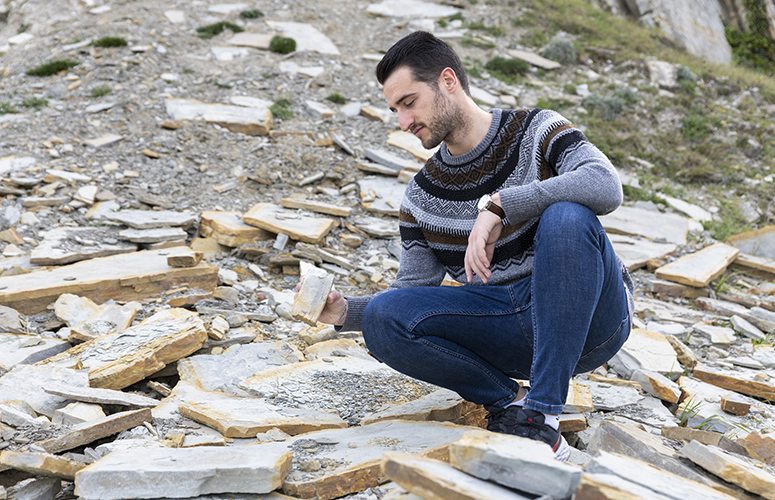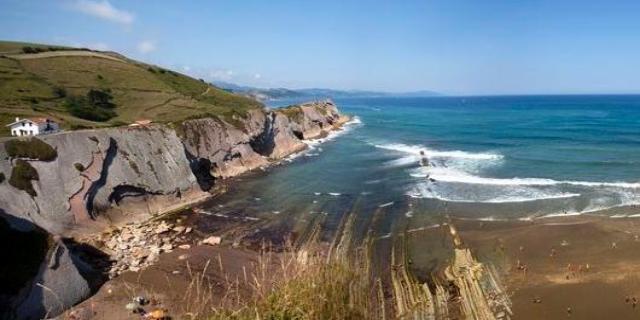Rockfall on the cliffs of the Basque coast is a very common phenomenon, as well as a real danger for people visiting the beaches located at their foot. A study by the Hydro-Environmental Processes group of the UPV/EHU has studied the barrier effect exerted by the dunes naturally present on the beach of Barinatxe, Bizkaia. The results show that the protection is total, as well as providing ecological value to the coastal ecosystem.
Jon Ander Clemente, researcher of the Hydro-Environmental Processes (HGI) research group of the UPV/EHU’s Faculty of Science and Technology, seeks to naturalise these protective measures as far as possible.
By creating 3D models of these areas using drones or laser scanners, the research group tracks and monitors the trajectories, size, advance and other parameters of the rocks that fall in the study areas. This allows them to assess the susceptibility of the beaches to rockfall from adjacent cliffs and propose a series of measures and actions more in line with nature to protect the beaches while respecting the natural environment.
Clemente said how it is developed locally, with very humble funding, but they are very happy with the impact it is having on the scientific community: it is being cited in different studies, and it is already being tested elsewhere. For example, in the natural park of Portofino, one of the most important in Italy, they are using this methodology in its coves.
Although it is currently being used to stop rockfall on beaches, the researcher believes that this methodology can be used in any environment where there is danger to people related to rockfall.


Desarrollan una metodología que busca soluciones naturales a los desprendimientos de rocas en playas
El estudio de la UPV/EHU demuestra que en el caso de Barinatxe, en el municipio vizcaíno de Sopelana, las dunas protegen al 100 % la zona de recreo
La caída de rocas en los acantilados de la costa vasca es un fenómeno muy habitual, así como un peligro real para la gente que visita las playas localizadas a sus pies. Un estudio del grupo Procesos Hidro-Ambientales de la UPV/EHU ha estudiado el efecto barrera que ejercen las dunas naturalmente presentes en la playa de Barinatxe, Bizkaia. Los resultados muestran que la protección es total, además de aportar valor ecológico al ecosistema costero.
Siendo las playas zonas de recreo muy frecuentadas, la protección de las personas es de máxima prioridad en los arenales a los pies de acantilados donde es habitual que se produzcan desprendimientos de rocas. Tradicionalmente se ha recurrido a la construcción de diques, mallas y barreras para este fin, que además de su alto coste de construcción y mantenimiento, tienen un gran impacto visual y ambiental en el entorno. “En nuestro grupo de investigación, buscamos naturalizar en la medida de lo posible estas medidas protectoras”, comenta Jon Ander Clemente, investigador del grupo de investigación Procesos Hidro-Ambientales (HGI) de la Facultad de Ciencia y Tecnología de la UPV/EHU. Existen, además, zonas protegidas, de alto valor ecológico y/o geomorfológico, como el Geoparque de la costa vasca, en las que no se pueden hacer ese tipo intervenciones tradicionales.
Mediante la creación de modelos 3D de estas zonas utilizando drones o laser escáner, el grupo de investigación realiza el seguimiento y la monitorización de las trayectorias, el tamaño, el avance y otros parámetros de las rocas que caen en las zonas de estudio. Esto les permite “evaluar la susceptibilidad de las playas frente a la caída de rocas de los acantilados adyacentes y proponer una serie de medidas y actuaciones más acordes con la naturaleza para proteger las playas y a la vez respetar el entorno natural”, detalla el investigador.
En el caso de la playa de Barinatxe (ubicada entre Sopela y Getxo, Bizkaia), del estudio realizado concluyeron que es el sistema dunar naturalmente existente a los pies del acantilado el que protege la playa de la caída de las rocas. Así lo explica Clemente: “Dadas sus características, estas dunas generan una cuneta natural, que ejerce como barrera y retiene las rocas. Nuestro modelo 3D nos muestra que, si esta barrera natural se degradara y desapareciera, las rocas llegarían hasta la playa donde la gente suele acudir, y se correría un gran riesgo. En este momento, la protección que ejerce el sistema dunar es del 100 %. Además, este entorno ha sido estudiado desde el punto de vista de la biodiversidad, y se ha visto que las especies que crecen allí son importantes, y encima la vegetación mantiene firmes las dunas. Estos resultados demuestran la eficacia de las llamadas soluciones basadas en la naturaleza (nature-based solutions en inglés)”.
El investigador aclara que el haber probado la eficacia de las dunas no significa que vayan a promover la instalación de sistemas dunares en todas las playas que corren el mismo riesgo que la de Barinatxe. “Hay que adaptar las soluciones a la morfología propia de cada lugar. Sí que puede haber playas donde se pueda generar sistemas dunares, pero en otras será necesario realizar intervenciones con mayor impacto. En estos casos, nuestro modelo 3D permite definir las necesidades exactas de cada lugar, y, por ejemplo, puede servir para determinar la altura de la barrera que es necesario construir.”
Un modelo 3D que está atrayendo la atención de la comunidad científica
Clemente se muestra complacido por la recepción que ha tenido la metodología desarrollada: “Lo desarrollamos localmente, con una financiación muy humilde, pero estamos muy contentos con el impacto que está teniendo en la comunidad científica: está siendo citado en diferentes estudios, y ya lo están probando en otros lugares. Por ejemplo, en el parque natural de Portofino, uno de los más importantes de Italia, estamos utilizando nuestra metodología en sus calas”.
Aunque actualmente está siendo utilizado para detener la caída de las rocas en las playas, el investigador considera que esta metodología puede ser utilizada en cualquier entorno donde exista peligro para las personas relacionado con la caída de rocas. En el caso concreto del efecto de las dunas, “se podrían hacer estudios similares en sistemas desérticos. Lo que es interesante de esta metodología es el planteamiento que hace para solucionar un problema, que muestra los buenos resultados que da el acercarse más a la naturaleza y realizar actuaciones más sostenibles”, concluye.
Información complementaria
La metodología desarrollada para la presente investigación fue elaborada como parte de la tesis doctoral de Jon Ander Clemente, miembro del grupo de investigación Procesos Hidro-Ambientales (HGI) de la Facultad de Ciencia y Tecnología de la UPV/EHU, dirigido por Iñaki Antigüedad, catedrático de Hidrogeología. En el presente estudio, el grupo de investigación ha contado con la colaboración de diferentes grupos italianos (el Instituto ISPRA y la Universidad de Génova), con los que han continuado trabajando en el estudio llevado a cabo en el parque natural de Portofino.

Hondartzetako harri-jausietarako irtenbide naturalak bilatzen dituen metodologia garatu dute
UPV/EHUren ikerketak erakutsi duenez, Sopelako Barinatxeren kasuan, dunek % 100 babesten dute aisialdirako gune hori
Harri-jausiak oso fenomeno ohikoak dira euskal itsaslabarretan, bai eta benetako arriskua ere labar horien azpiko hondartzetara joaten den jendearentzat. UPV/EHUko Prozesu Hidrikoen eta Ingurumenekoen ikertaldeak egindako azterlan batean, Bizkaiko Barinatxe hondartzan berezkoak diren dunen hesi-efektua aztertu da. Emaitzek erakutsi dute dunek erabateko babesa ematen dutela eta, gainera, balio ekologikoa eransten diotela kostaldeko ekosistemari.
Hondartzak jende ugari ibiltzen den aisialdirako guneak direnez, lehentasunezkoa da itsaslabarren azpiko hareatzetan dagoen jendea babestea, harriak erori ohi baitira bertara. Harriei eusteko, dikeak, sareak eta hesiak eraiki izan dira tradizionalki, baina haiek eraikitzea eta mantentzea garestia da, eta, gainera, inpatu bisual eta ingurumen-inpaktu handia eragiten dute eremuan. UPV/EHUko Zientzia eta Teknologia Fakultateko Prozesu Hidrikoen eta Ingurumenekoen ikertaldeko (HGI) ikertzaile Jon Ander Clementek azaldu duenez, “babes-neurri horiek ahal den neurrian naturalizatzea da gure ikertaldearen xedea”. Gainera, balio ekologiko eta/edo geomorfologiko handiko eremu babestuetan, hala nola euskal kostaldeko Geoparkean, ezin da mota horretako esku-hartze tradizionalik egin.
Droneak edo laser eskanerra erabiliz, eremu horien 3Dko ereduak sortu dira; horrela, ikertaldeak azterketa-eremuetara erortzen diren harrien ibilbideen, tamainaren, aitzinamenduaren eta beste zenbait parametroren jarraipena eta monitorizazioa egiten du. Horri esker, “hondartzek inguruko itsaslabarretatik erortzen diren harriekiko duten zaurgarritasuna ebalua daiteke, eta naturarekin bateragarriagoak diren neurriak eta jarduketak proposa daitezke hondartzak babesteko eta, aldi berean, ingurune naturala errespetatzeko”, zehaztu du ikertzaileak.
Bizkaiko Barinatxe hondartzaren kasuan (Sopela eta Getxo artean dago), azterlanetik ondorioztatu zuten ezen itsaslabarraren oinean dagoen berezko duna-sistemak babesten duela hondartza harri-jausietatik. Horrela azaldu du Clementek: “Beren ezaugarriak direla eta, duna horiek areka natural bat eratzen dute, eta hark, hesi-lana eginez, harriak atxikitzen ditu. Gure 3Dko ereduak erakusten digunez, hesi natural hori narriatu eta desagertuko balitz, harriak jendea joaten den hondartzaraino iritsiko lirateke, eta arrisku-egoera handia sortuko litzateke. Une honetan, duna-sistemak % 100eko babesa ematen du. Horrez gain, ingurune hori biodibertsitatearen ikuspegitik aztertu da, eta ikusi da bertan hazten diren espezieak garrantzitsuak direla eta, gainera, landarediak tinko eusten diela dunei. Emaitza horiek naturan oinarritutako soluzioen (nature-based solutions ingelesez) eraginkortasuna erakusten dute”.
Ikertzaileak argitu duenez, dunen eraginkortasuna egiaztatu izanak ez du esan nahi duna-sistemen ezarpena sustatuko dutenik Barinatxeko hondartzaren pareko arriskua duten hondartza guztietan. “Konponbideak leku bakoitzaren berezko morfologiara egokitu behar dira. Baliteke hondartza batzuetan duna-sistemak sortzeko aukera egotea, baina beste batzuetan inpaktu handiagoko esku-hartzeak egin beharko dira. Kasu horietan, gure 3Dko ereduak aukera ematen du leku bakoitzaren behar zehatzak definitzeko; esate baterako, eraiki behar den hesiaren altuera zehazteko balio dezake”.
Komunitate zientifikoaren arreta erakartzen ari den 3Dko eredua
Clemente pozik dago garatutako metodologiak izan duen harrerarekin: “Tokian-tokian garatu genuen, finantziazio oso apalarekin, baina oso pozik gaude komunitate zientifikoan izaten ari den inpaktuarekin: zenbait ikerketatan aipatu dute, eta beste leku batzuetan ere probatzen ari dira. Esate baterako, Portofinoko parke naturalean —Italiako garrantzitsuenetako bat da—, gure metodologia baliatzen ari gara kaletan”.
Gaur egun metodologia hau hondartzetako harri-jausiak gelditzeko erabiltzen ari dira, baina ikertzaileak uste du harri-jausiak pertsonentzat arriskutsuak izan daitezkeen ingurune orotan erabil daitekeela. Dunen efektuaren kasu zehatzean, “antzeko azterketak egin litezke basamortu-sistemetan. Metodologia honetan, oso interesgarria da arazoa konpontzeko egiten den planteamendua; izan ere, ikusi da naturara gehiago hurbiltzeak eta jarduketa jasangarriagoak gauzatzeak emaitza onak ematen dituela”, ondorioztatu du.
Informazio osagarria
Ikerketa honetarako garatutako metodologia UPV/EHUko Zientzia eta Teknologia Fakultateko Prozesu Hidrikoen eta Ingurumenekoen ikertaldeko (HGI) kide Jon Ander Clementeren doktore-tesiaren zati gisa landu zen. Tesi hori Iñaki Antigüedad Hidrogeologiako katedradunak zuzendu zuen. Ikerketa honetan, ikertaldeak Italiako zenbait talderen laguntza izan du (ISPRA Institutua eta Genoako Unibertsitatea), eta haiekin lanean jarraitu du Portofinoko parke naturalean egin den azterlanean.


